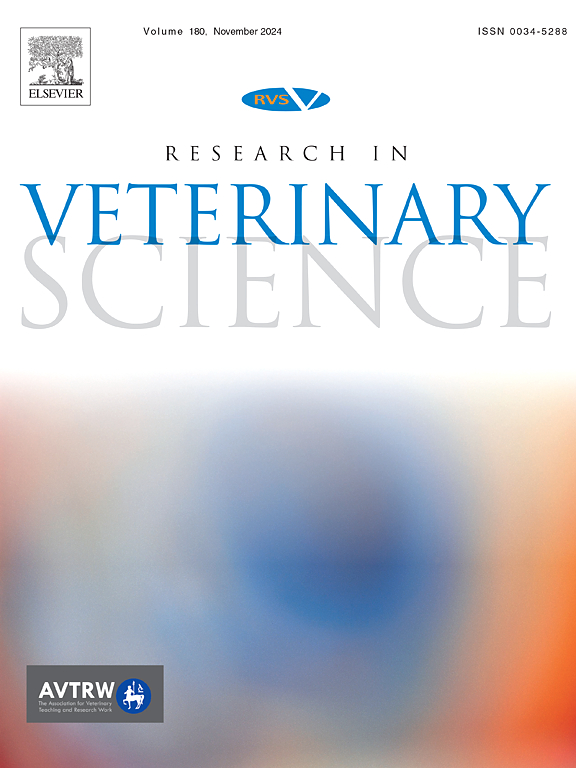Evaluation of the quality of life-enhancing effect of allogeneic feline adipose mesenchymal stem cells in cats with osteoarthritis: A pilot study
IF 2.2
3区 农林科学
Q1 VETERINARY SCIENCES
引用次数: 0
Abstract
Osteoarthritis (OA) is a progressive degenerative disease in older cats, and often leads to decreased quality of life (QOL). Mesenchymal stem cells (MSCs) have been used in novel therapies for inflammatory diseases. We aimed to evaluate quantitatively allogeneic adipose-derived MSC (ADSC) therapy in cats with naturally occurring OA, based on QOL assessment resources. To characterize the in vitro properties of ADSCs, we estimated ADSCs from four healthy cats with respect to morphology, differentiation potential, and immunomodulatory potential. Six cats with OA were administered a single intravenous injection of allogeneic ADSCs. Based on the feline musculoskeletal pain index (FMPI), the outcome measure was QOL. The cultured cells were adherent, exhibited a spindle shape without becoming flattened or large, and maintained doubling time until passage 5. After induction, the cells had osteogenic, adipogenic, and chondrogenic phenotypes. These cells expressed CD44 and CD90 and lacked expression of CD14 and CD45, had significantly suppressed the production of interferon -ɤ released from mitogen-stimulated lymphocytes (P < 0.05). The FMPI of all cats with OA significantly increased one month after ADSC therapy (P < 0.05). No adverse effects associated with ADSC administration were observed during follow-up in any of the cats. In conclusion, ADSC therapy with immunomodulatory potential could have beneficial effects on the QOL in cats with OA. Further research is necessary to carry out larger studies of the effectiveness of ADSC therapy.
评估同种异体猫脂肪间充质干细胞对骨关节炎猫的生活质量增强作用:一项初步研究
骨关节炎(OA)是老年猫的一种进行性退行性疾病,经常导致生活质量(QOL)下降。间充质干细胞(MSCs)已被用于炎症性疾病的新疗法。我们的目的是基于生活质量评估资源,定量评估自然发生的OA猫的同种异体脂肪来源的MSC (ADSC)治疗。为了表征ADSCs的体外特性,我们估计了来自四只健康猫的ADSCs的形态学、分化潜能和免疫调节潜能。6只患有OA的猫被单次静脉注射同种异体ADSCs。以猫肌肉骨骼疼痛指数(FMPI)为衡量指标,以生活质量为衡量指标。培养的细胞贴壁,呈纺锤形,未变扁或变大,并保持倍增时间至传代5。诱导后,细胞具有成骨、成脂和成软骨表型。这些细胞表达CD44和CD90,缺乏CD14和CD45的表达,显著抑制了分裂原刺激淋巴细胞释放的干扰素- γ的产生(P <;0.05)。ADSC治疗一个月后,所有OA猫的FMPI均显著升高(P <;0.05)。在随访期间,没有观察到任何猫与ADSC相关的不良反应。综上所述,具有免疫调节潜力的ADSC治疗可能对OA猫的生活质量有有益的影响。进一步的研究需要对ADSC治疗的有效性进行更大规模的研究。
本文章由计算机程序翻译,如有差异,请以英文原文为准。
求助全文
约1分钟内获得全文
求助全文
来源期刊

Research in veterinary science
农林科学-兽医学
CiteScore
4.40
自引率
4.20%
发文量
312
审稿时长
75 days
期刊介绍:
Research in Veterinary Science is an International multi-disciplinary journal publishing original articles, reviews and short communications of a high scientific and ethical standard in all aspects of veterinary and biomedical research.
The primary aim of the journal is to inform veterinary and biomedical scientists of significant advances in veterinary and related research through prompt publication and dissemination. Secondly, the journal aims to provide a general multi-disciplinary forum for discussion and debate of news and issues concerning veterinary science. Thirdly, to promote the dissemination of knowledge to a broader range of professions, globally.
High quality papers on all species of animals are considered, particularly those considered to be of high scientific importance and originality, and with interdisciplinary interest. The journal encourages papers providing results that have clear implications for understanding disease pathogenesis and for the development of control measures or treatments, as well as those dealing with a comparative biomedical approach, which represents a substantial improvement to animal and human health.
Studies without a robust scientific hypothesis or that are preliminary, or of weak originality, as well as negative results, are not appropriate for the journal. Furthermore, observational approaches, case studies or field reports lacking an advancement in general knowledge do not fall within the scope of the journal.
 求助内容:
求助内容: 应助结果提醒方式:
应助结果提醒方式:


